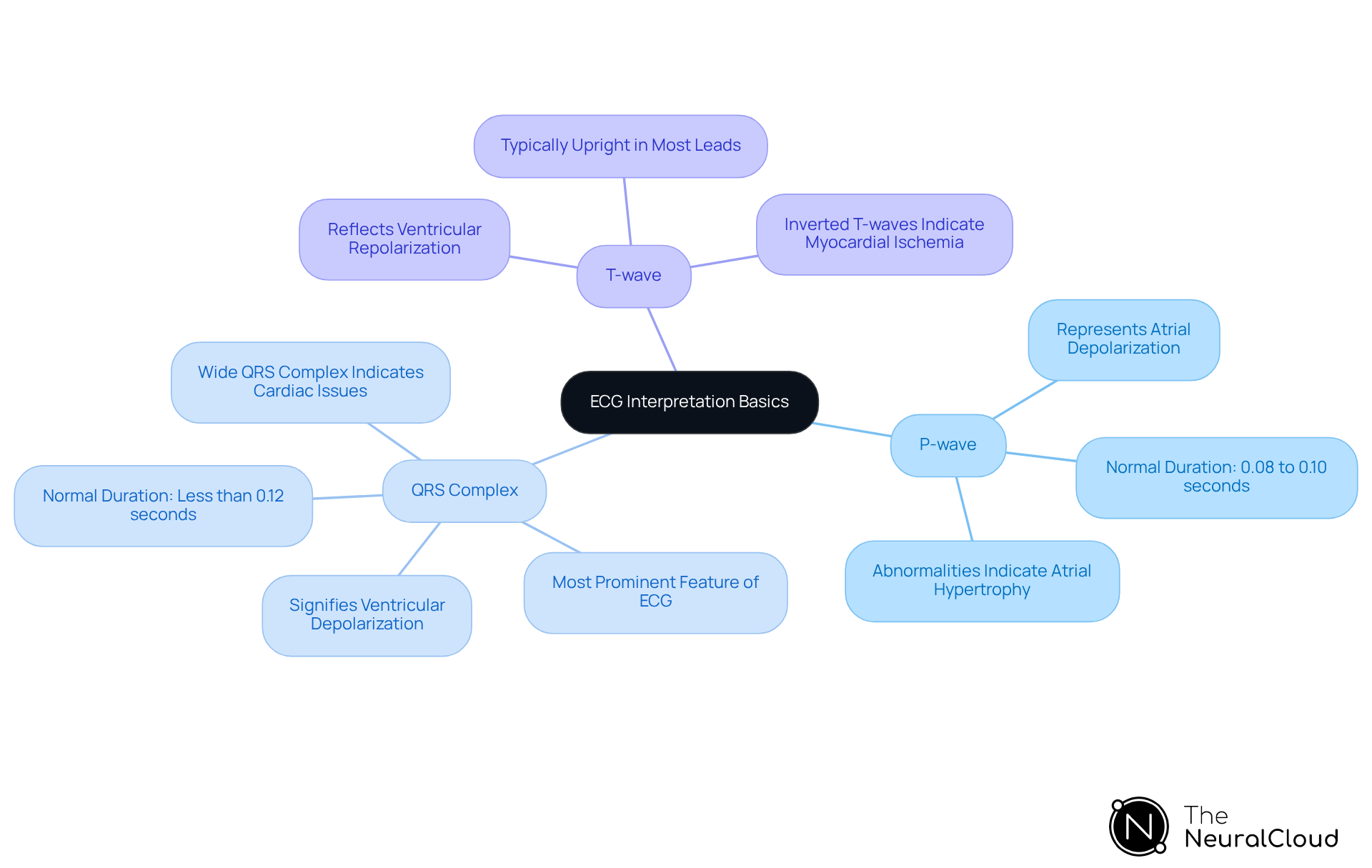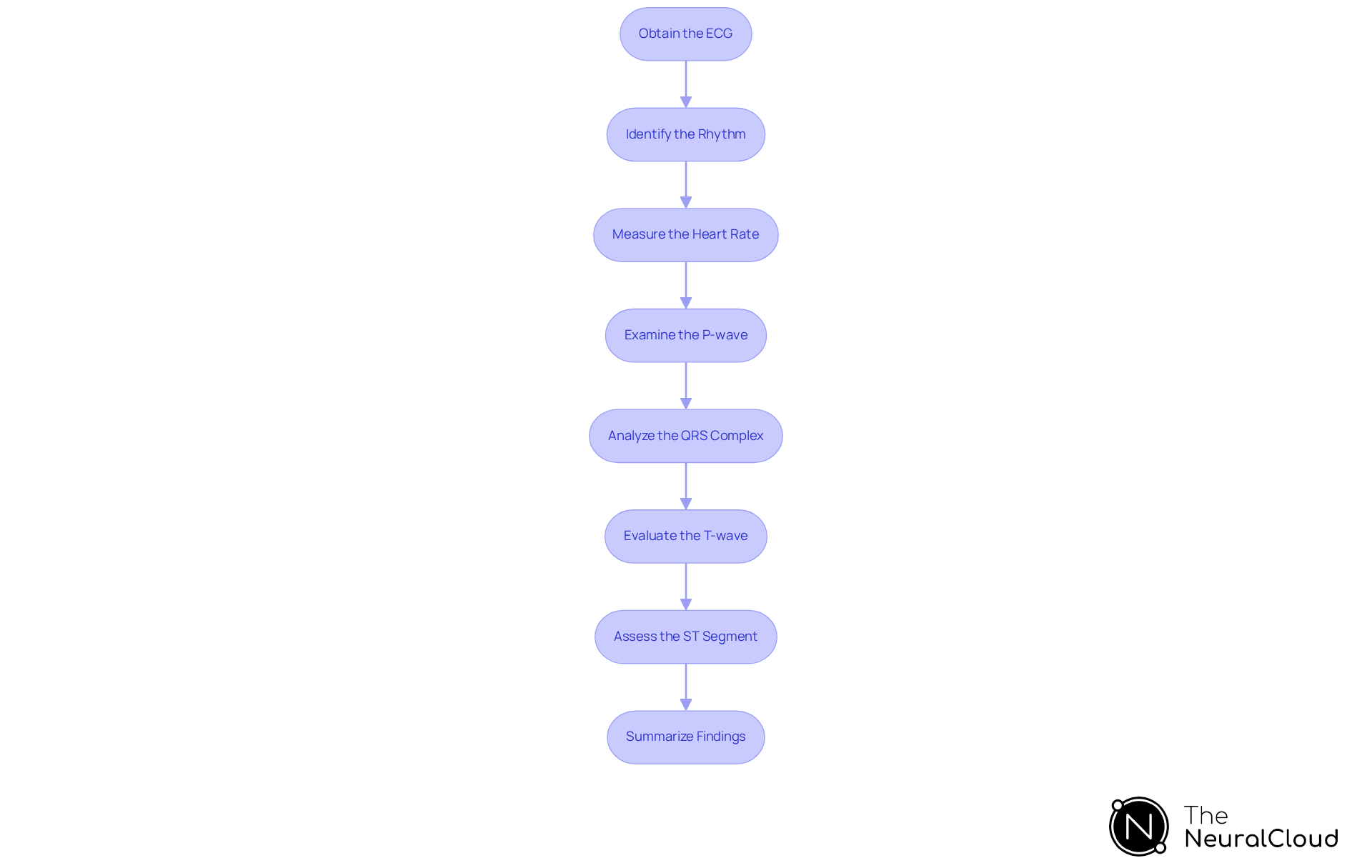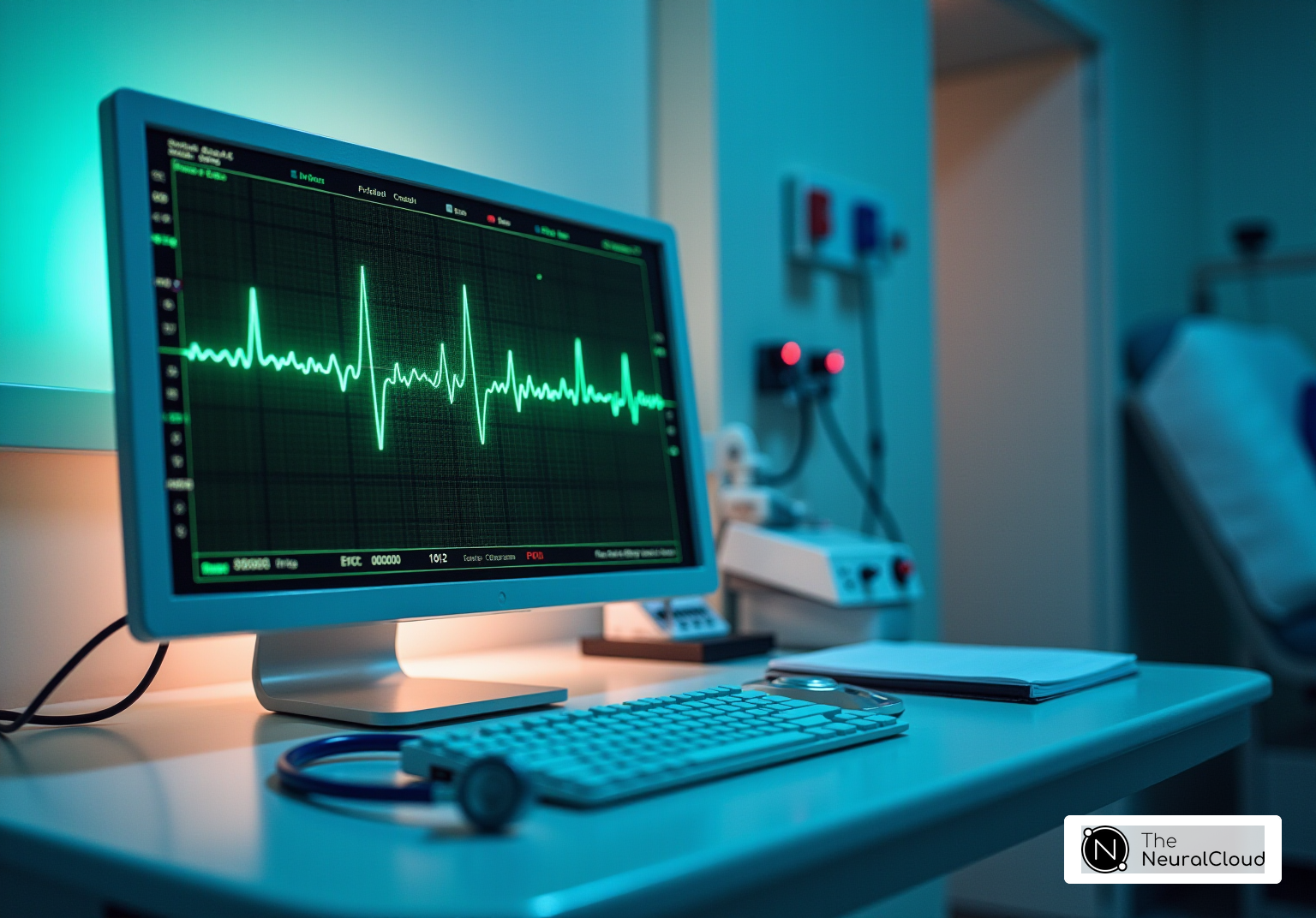Overview
The article presents a detailed guide on effectively reading and interpreting ECG results through an understanding of essential waveform components and systematic analysis procedures. It highlights the challenges faced in ECG analysis, such as artifact noise and lead misplacement. A key focus is on mastering the P-wave, QRS complex, and T-wave, which are critical for accurate interpretation.
Furthermore, it introduces the MaxYield™ platform, detailing its features that enhance ECG analysis. By leveraging advanced technologies, MaxYield™ improves diagnostic accuracy and ultimately benefits patient outcomes. This comprehensive approach ensures that healthcare professionals can navigate common challenges with greater ease and precision.
Introduction
Understanding the intricacies of ECG interpretation is crucial for healthcare professionals who seek to improve their diagnostic accuracy. This guide provides an overview of the challenges associated with ECG analysis, specifically highlighting how practitioners can navigate common pitfalls. By delving into the fundamental components of ECG waveforms, we offer a structured approach to effectively reading and analyzing results.
The MaxYield™ platform addresses these challenges by streamlining the interpretation process, thereby enhancing the accuracy of ECG analysis. Ultimately, this exploration not only covers core techniques for mastering ECG analysis but also presents innovative solutions that aim to improve patient outcomes.
Understand the Basics of ECG Interpretation
A solid grasp of the fundamental components of an ECG waveform is crucial for understanding how to read ECG results effectively. An ECG typically comprises several key elements:
- P-wave: Represents atrial depolarization, indicating the electrical activity that triggers atrial contraction.
- QRS complex: Signifies ventricular depolarization and is the most prominent feature of the ECG, reflecting the heart's main pumping action.
- T-wave: Reflects ventricular repolarization, marking the recovery phase of the ventricles after contraction.
Familiarizing yourself with the normal duration and amplitude of these components is essential:
- P-wave duration: 0.08 to 0.10 seconds.
- QRS duration: Less than 0.12 seconds.
- T-wave: Typically upright in most leads, indicating normal repolarization.
Understanding these basics is vital for learning how to read ECG results and identifying abnormalities like arrhythmias or ischemic changes, which are critical for clinical decision-making. A systematic approach to interpreting these waveforms can clarify how to read ECG results, making ECG analysis more accessible and effective in clinical practice. For instance, recognizing P-wave abnormalities can aid in diagnosing conditions like atrial hypertrophy, while a wide QRS complex may indicate significant cardiac issues, necessitating timely intervention. Furthermore, inverted T waves are critical for diagnosing myocardial ischemia or infarction.
With the integration of advanced technologies such as , healthcare professionals can significantly enhance their ECG interpretation skills. MaxYield™ utilizes advanced noise filtering and unique wave recognition, enabling the quick isolation of ECG waves even in recordings with high levels of noise and interference. This adaptability ensures that previously obscured sections of lengthy Holter, 1-Lead, and patch monitor recordings can be salvaged, ultimately improving diagnostic accuracy and patient outcomes.
By mastering these components and leveraging innovative solutions, healthcare professionals can address challenges such as physiological variability and signal artifacts, enhancing their overall diagnostic capabilities. As John R. Hampton states, 'The ECG is easy to understand,' emphasizing the importance of viewing it as an aid to diagnosis rather than a definitive solution.

Follow Step-by-Step Procedures for ECG Analysis
To analyze an ECG effectively, follow these systematic steps:
- Obtain the ECG: Ensure you have a clear, high-quality ECG printout or digital display. Utilizing the MaxYield™ platform can streamline this process by providing , ensuring clarity in the ECG data.
- Identify the Rhythm: Assess the regularity of the R-R intervals. Determine if the rhythm is regular or irregular, as this is crucial for further analysis. The AI-powered algorithms of the MaxYield™ platform can assist in identifying rhythm irregularities more efficiently.
- Measure the Heart Rate: For a quick estimate, count the number of QRS complexes in a 10-second strip and multiply by 6. This method provides a reliable heart rate approximation, essential for diagnosing conditions like bradycardia (less than 60 bpm) or tachycardia (100-150 bpm). The normal heart rate range is 60-100 bpm. Automated ECG analysis with the MaxYield™ platform can enhance the accuracy of this measurement.
- Examine the P-wave: Check for the presence, shape, and duration of the P-wave. It should be consistent across leads, indicating proper atrial depolarization. The MaxYield™ platform helps in maintaining a consistently clean signal, which is crucial for accurate assessments.
- Analyze the QRS Complex: Measure the duration of the QRS segment, which should be between 0.04 and 0.10 seconds. Assess its morphology—narrow complexes suggest normal conduction, while wide complexes may indicate a bundle branch block or other underlying issues. The platform's automated annotations can speed up this analysis without compromising quality.
- Evaluate the T-wave: Look for abnormalities in the T-wave's shape or direction. Inverted T-waves can indicate ischemia, while peaked T-waves may suggest hyperkalemia. The MaxYield™ platform enhances the reliability of these evaluations through advanced signal processing.
- Assess the ST Segment: Check for ST segment elevation or depression, which can signal ischemia or myocardial infarction. Elevation greater than 1 mm in two or more contiguous limb leads is particularly concerning. The platform's capabilities in noise filtering can significantly aid in this assessment.
- Summarize Findings: Document your observations and compare them against normal values to identify any abnormalities. This step is vital for ensuring precise clinical decisions and efficient management of individuals. Utilizing the MaxYield™ platform can enhance your return on investment by improving throughput and reducing time spent on manual tasks.
By adhering to these best practices and utilizing the innovative features available, healthcare professionals can systematically analyze how to read ECG results, thereby enhancing diagnostic accuracy and improving patient outcomes. For instance, a case study on calculating heart rate in regular rhythm illustrates the practical application of these steps, reinforcing the importance of accurate heart rate assessment.

Troubleshoot Common ECG Reading Issues
When interpreting ECGs, several common challenges may arise:
- Artifact Noise: This interference can obscure true ECG signals, leading to misdiagnosis. The 'Neural Cloud Solutions' platform excels in identifying and labeling critical data, even in recordings with high levels of noise and interference. Proper electrode placement is crucial; ensure leads are securely attached and check for loose connections. Studies indicate that proper electrode placement and skin preparation can reduce artifacts by up to 70%. If noise persists, re-running the ECG may be necessary. However, with MaxYield™, previously obscured sections of lengthy Holter and patch monitor recordings can be salvaged, thereby enhancing diagnostic accuracy.
- Poor Signal Quality: Unclear ECG readings often arise from insufficient preparation of the individual. It is essential to verify that the individual is relaxed and that the skin is clean and dry before electrode placement. Involuntary muscle movements, like shivering, can create muscle tremor distortions, complicating interpretation. Moreover, wandering baseline irregularities can arise from patient movement or loose/dry electrodes. The advanced of the system help isolate ECG waves from such disturbances, significantly improving signal clarity.
- Misinterpretation of Waveforms: Familiarity with normal waveform variations is essential to avoid misdiagnosis. Reference materials or software tools can assist in identifying abnormalities. Notably, a misdiagnosis rate of 14.3% among residents has been linked to ECG distortions, underscoring the importance of precise interpretation. With this solution, healthcare professionals can leverage automated labeling to enhance their understanding of waveform variations, thus reducing the risk of misinterpretation.
- Lead Misplacement: If the ECG appears abnormal, it is vital to double-check lead placement. Incorrect positioning can result in misleading outcomes, as demonstrated by instances where loose lead artifacts were found in individuals with excessive sweating. Furthermore, minimizing electrical interference by positioning ECG machines away from power sources can enhance signal quality. The system continuously evolves its algorithms with each use, ensuring that healthcare professionals can depend on its accuracy and efficiency over time.
By recognizing these issues and implementing effective troubleshooting strategies, alongside the advanced capabilities of MaxYield™, healthcare professionals can significantly enhance their understanding of how to read ECG results and improve patient outcomes.

Conclusion
Mastering the art of ECG interpretation is an essential skill for healthcare professionals, enabling informed clinical decisions based on accurate readings. Understanding the fundamental components of an ECG waveform—such as the P-wave, QRS complex, and T-wave—forms the backbone of effective analysis. By familiarizing oneself with these elements and their normal ranges, practitioners can identify abnormalities and respond promptly to critical cardiac conditions.
The challenges in ECG analysis often stem from obtaining high-quality readings and troubleshooting common issues like artifact noise and poor signal quality. The MaxYield™ platform addresses these challenges by providing advanced tools that enhance diagnostic accuracy. Features include:
- Efficient rhythm identification
- Precise heart rate measurement
- Comprehensive waveform analysis
All designed to streamline the ECG interpretation process.
By integrating the MaxYield™ platform into their practice, healthcare professionals gain significant advantages. The platform not only simplifies the analysis of ECGs but also improves the overall quality of patient care. By adopting these innovative technologies, practitioners can enhance their competence in interpreting ECG results, leading to better patient outcomes.
In the ever-evolving field of cardiology, the ability to interpret ECG results accurately cannot be overstated. Embracing a comprehensive approach to ECG interpretation, supported by advanced platforms like MaxYield™, contributes to the broader goal of advancing cardiac care. This commitment to excellence not only benefits individual practitioners but also enhances the standard of care provided to patients.
Frequently Asked Questions
What are the main components of an ECG waveform?
The main components of an ECG waveform are the P-wave, QRS complex, and T-wave. The P-wave represents atrial depolarization, the QRS complex signifies ventricular depolarization, and the T-wave reflects ventricular repolarization.
What is the normal duration for the P-wave, QRS complex, and T-wave?
The normal duration for the P-wave is 0.08 to 0.10 seconds, the QRS complex duration is less than 0.12 seconds, and the T-wave is typically upright in most leads.
Why is it important to understand the basics of ECG interpretation?
Understanding the basics of ECG interpretation is vital for identifying abnormalities like arrhythmias or ischemic changes, which are critical for clinical decision-making and effective patient care.
How can P-wave abnormalities assist in diagnosis?
Recognizing P-wave abnormalities can aid in diagnosing conditions such as atrial hypertrophy, indicating potential cardiac issues that may require intervention.
What does a wide QRS complex indicate?
A wide QRS complex may indicate significant cardiac issues, necessitating timely intervention by healthcare professionals.
What is the significance of inverted T waves in an ECG?
Inverted T waves are critical for diagnosing myocardial ischemia or infarction, indicating possible heart problems that need to be addressed.
How do advanced technologies like Neural Cloud Solutions enhance ECG interpretation?
Advanced technologies such as Neural Cloud Solutions improve ECG interpretation by utilizing noise filtering and unique wave recognition to isolate ECG waves even in recordings with high levels of noise, enhancing diagnostic accuracy.
What is the role of MaxYield™ in ECG analysis?
MaxYield™ helps salvage previously obscured sections of lengthy Holter, 1-Lead, and patch monitor recordings, ultimately improving diagnostic accuracy and patient outcomes.
What challenges can innovative solutions address in ECG interpretation?
Innovative solutions can address challenges such as physiological variability and signal artifacts, enhancing healthcare professionals' overall diagnostic capabilities.
How should the ECG be viewed according to John R. Hampton?
John R. Hampton emphasizes that the ECG should be viewed as an aid to diagnosis rather than a definitive solution, highlighting its role in clinical practice.






